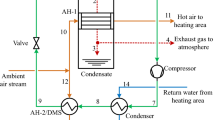Abstract
To achieve the deep recovery of exhaust waste heat, a combined cooling heating and power (CCHP) dynamic exhaust low temperature waste heat coupled air source heat pump system is proposed in this paper. Aspen Plus software was used to simulate the system and analyze the effects of the recyclable waste heat of the system, the coefficient of performance (COP) of the heat pump and the impact of the primary energy utilization rate. The results showed that under the design condition, the exhaust waste heat of CCHP system was 1.22 kW, the recyclable waste heat of heat pump system was up to 1.07 kW, the exhaust waste heat recovery rate was 87.7%. The COP was up to 4.66, increased 39.5%. The primary energy utilization efficiency was increased by 3.9%. It solves the problem of heat pump evaporator frosting and poor performance of low temperature in cold regions. This study provides an important reference for the combined and efficient application of CCHP systems and heat pump units.
Similar content being viewed by others
References
Afzali SF, Mahalec V (2018). Novel performance curves to determine optimal operation of CCHP systems. Applied Energy, 226: 1009–1036.
Gao P, Li W, Cheng Y, Tong Y, Dai Y, Wang R (2014). Thermodynamic performance assessment of CCHP system driven by different composition gas. Applied Energy, 136: 599–610.
Gou X, Fu Y, Shah I, Li Y, Xu G, Yang Y, Wang E, Liu L, Wu J (2016). Research on a household dual heat source heat pump water heater with preheater based on ASPEN PLUS. Energies, 9(12): 1026.
Hanafizadeh P, Eshraghi J, Ahmadi P, Sattari A (2016). Evaluation and sizing of a CCHP system for a commercial and office buildings. Journal of Building Engineering, 5: 67–78.
He Z, Zhang Y, Wu Z, Ma H, Dong S (2017). Experimental study on a bifunctional heat utilization system of heat pump and power generation using low-grade heat source. Applied Thermal Engineering, 124: 71–82.
Jiang J, Gao W, Gao Y, Wei X, Kuroki S (2016). Performance analysis of CCHP system for university campus in north China. Procedia -Social and Behavioral Sciences, 216: 361–372.
Li Y, Li W, Liu Z, Lu J, Zeng L, Yang L, Xie L (2017). Theoretical and numerical study on performance of the air-source heat pump system in Tibet. Renewable Energy, 114: 489–501.
Liu F, Wang L, Wang Q, Wang H (2017). Experiment study on heating performance of solar-air source heat pump unit. Procedia Engineering, 205: 3873–3878.
Luo Z, Wu Z, Li ZY, Cai HY, Li BJ, Gu W (2017). A two-stage optimization and control for CCHP microgrid energy management. Applied Thermal Engineering, 125: 513–522.
Mago PJ, Hueffed AK (2010). Evaluation of a turbine driven CCHP system for large office buildings under different operating strategies. Energy and Buildings, 42: 1628–1636.
Miller S, Shemer H, Semiat R (2015). Energy and environmental issues in desalination. Desalination, 366: 2–8.
Shang S, Li X, Wu W, Wang B, Shi W (2017). Energy-saving analysis of a hybrid power-driven heat pump system. Applied Thermal Engineering, 123: 1050–1059.
Shen J, Guo T, Tian Y, Xing Z (2018). Design and experimental study of an air source heat pump for drying with dual modes of single stage and cascade cycle. Applied Thermal Engineering, 129: 280–289.
Smith AD, Mago PJ (2014). Effects of load-following operational methods on combined heat and power system efficiency. Applied Energy, 115: 337–351.
Tian X, Deng S, Kang L, Zhao J, An Q (2018). Study on heat and power decoupling for CCHP system: Methodology and case study. Applied Thermal Engineering, 142: 597–609.
Touchie MF, Pressnail KD (2014). Testing and simulation of a low-temperature air-source heat pump operating in a thermal buffer zone. Energy and Buildings, 75: 149–159.
Underwood CP, Royapoor M, Sturm B (2017). Parametric modelling of domestic air-source heat pumps. Energy and Buildings, 139: 578–589.
Wang L, Lu J, Wang W, Ding J (2016). Energy, environmental and economic evaluation of the CCHP systems for a remote island in south of China. Applied Energy, 183: 874–883.
Wang F, Liang C, Yang M, Zhang X (2015). Preliminary study of a novel defrosting method for air source heat pumps based on superhydrophobic fin. Applied Thermal Engineering, 90: 136–144.
Wu Q, Ren H (2017). Design and evaluation of a CCHP based micro-grid for an urban area. Energy Procedia, 143: 798–803.
Wu Z, Zhang H, You S, Zheng W, Guo J (2017). The collocation method of supplementary heat source of air-source heat pump system for space heating based on the MEBPT calculation. Energy Procedia, 142: 1427–1433.
Xu X, You S, Zheng X, Li H (2014). A survey of district heating systems in the heating regions of northern China. Energy, 77: 909–925.
Xue L, Guo X, Xing Z (2017). Experimental study of frost growth characteristics on surface of fin-tube heat exchanger. Energy Procedia, 105: 5114–5121.
Yang C, Wang X, Huang M, Ding S, Ma X (2017). Design and simulation of gas turbine-based CCHP combined with solar and compressed air energy storage in a hotel building. Energy and Buildings, 153: 412–420.
Zhang X, Chen H (2013). Thermodynamic analysis of heat pump heating supply systems with circulating water heat recovery. Proceedings of the CSEE, 33: 1–8. (in Chinese)
Zhao Z (2011). Research of working fluids of Engine exhaust gas waste heat recovery based on Organic Rankine Cycle (ORC). Master Thesis, Tianjin university, China. (in Chinese)
Acknowledgements
This work were supported by the Science and Technology Development Project Funding of Jilin Province, China (No. 20170203006SF), the Key Technology Research Project of Science and Technology Commission of Jilin Province, China (No. 20180201006SF), and the National Key Research and Development Program of China (No. 2018YFB0905104).
Author information
Authors and Affiliations
Corresponding author
Rights and permissions
About this article
Cite this article
Hong, W., Hao, J., Wang, J. et al. Performance analysis of combined cooling heating and power (CCHP) exhaust waste heat coupled air source heat pump system. Build. Simul. 12, 563–571 (2019). https://doi.org/10.1007/s12273-019-0520-x
Received:
Revised:
Accepted:
Published:
Issue Date:
DOI: https://doi.org/10.1007/s12273-019-0520-x




